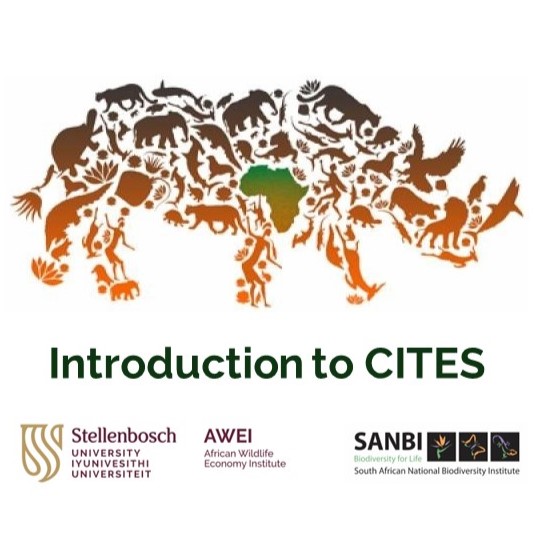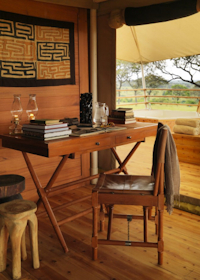CITES Module 3
 3 Biodiversity and trade policies in South Africa
3 Biodiversity and trade policies in South Africa
In this module you will explore the nexus between wildlife and trade in South Africa.
Lecture
- Click on the image below to stream the lecture on OneDrive (10 min)
- You can also download the lecture for listening offline
- Take notes while listening
 A selection of relevant South African policies
A selection of relevant South African policies
2004 - National Environmental Management: Biodiversity Act (NEMBA)
2015 – 2nd National Biodiversity Strategy and Action Plan 2015 – 2025 (NBSAP)
2016 - National Biodiversity Economy Strategy (NBES)
2023 - White Paper on the Conservation and Sustainable Use of South Africa’s Biodiversity as approved by Cabinet
2002 – International Trade Administration Act
2010 - South Africa’s Trade Policy and Strategy Framework (TPSF)
2012 - Understanding South Africa’s trade policy and performance
 A selection of policy statements
A selection of policy statements
The Minister must monitor… compliance… with an international agreement regulating international trade in specimens of endangered species...
National strategy for international trade in species and their parts… promotes biodiversity conservation, sustainable use and equitable… transformation CITES has a crucial role… as it dictates, through the gazetted...
CITES has a crucial role… as it dictates, through the gazetted CITES list regulations, the trade in a number of our biological resources in the wildlife and bioprospecting sub-sectors...
International commercial trade in rhino horn and elephant ivory is currently restricted by CITES. While South Africa may work towards submitting a proposal to CITES once conditions are favourable... until this is achieved, we should explore domestic options for trade.
Learning resources - videos
- While watching these videos, reflect on the learning questions provided
- Take notes while watching
Biodiversity Economy Innovation Conference
- The 2019 Biodiversity Economy Innovation conference brought together stakeholders from the wildlife industry, academia, traditional leadership and government to deliberate on innovative ideas that promote sustainable utilisation and conservation of the country’s biological resources.
- Q: How has the biodiversity economy approach of the government developed since 2019?
CITES CoP17 welcome message from South African Environment Minister Mrs Edna Molewa
- In 2015, South Africa hosted the 17th meeting of the CITES Conference of the Parties.
- Q: Where significant decisions for Africa made at this meeting?
 Learning resources - readings
Learning resources - readings
- While skimming through these documents, reflect on the learning questions provided
- Also, download documents for future reference
National Biodiversity Economy Strategy (NBES)
- The Wildlife Industry value chain is centred on game and wildlife farming/ranching activities that relate to the stocking, trading, breeding, and hunting of game, and all the services and goods required to support this value chain. The key drivers of this value chain include domestic hunters, international hunters and a growing retail market demand for wildlife products such as game meat and taxidermy products.
- Q: In South Africa, 'wildlife' often refers to wild animals. What terms are used for wild plants and for the trade in wild plant ingredients?
White Paper on Conservation and Sustainable Use of South Africa’s Biodiversity
- The White Paper sets forth the following vision: "A prosperous nation, living in harmony with nature, where biodiversity is conserved for present and future generations, and secures equitable livelihoods and improved human well-being".
- Q: What role does wild trade play in this vision?
Game Meat Strategy of South Africa
- This report formulates the strategy to expand, differentiate and formalise the game meat industry in SA which has shown considerable potential for growth. If developed appropriately, in the context of a biodiversity conservation and sustainable use perspective, this market could contribute favourably to economic development, job creation, food security and sectoral transformation.
- Q: What are the prospects for game meat exports from South Africa, including from CITES-listed species?
Integrated National Export Strategy (INES) OR “Export 2030”
- The development of this Integrated National Export Strategy (INES) or “Export 2030” therefore looked into the progress of South Africa’s export sector and identified priorities for enhanced export performance. The INES covers a basket of interventions at the macro and micro levels of export development and promotion.
- Q: How could the trade in wildlife products be supported by this strategy?
- This Export Manual is an update of the 2014 step-by-step Export Manual for exporters of South African fruit, vegetables, and nuts. The revised Export Manual strongly focuses on exporting to the EU market, which has given rise to sophisticated consumers who demand sustainable, inclusive supply chains and transparency.
- Q: How could the export of wildlife products to the European Union be supported by the guidance in this manual?
 Learning resources - websites
Learning resources - websites
- While browsing these websites, reflect on the learning questions provided
- Also, bookmark websites for future reference
- Sustainable use of South Africa’s natural resources though biased currently, contribute to poverty reduction and economic growth. Harvesting indigenous biological resources is a significant source of income for communities as it does not require a minimum level of education or professional skills rather indigenous skills.
- Q: What skills are need to harvest wildlife resources and bring wildlife products to market?
Wildlife Economy | Biodiversity Economy Investment Portal
- South Africa has an abundance of wildlife, which is one of the country’s key attractions and assets. The Wildlife Economy is distinguished by a unique combination of agriculture, ecotourism, and conservation characteristics that create jobs and benefit society and the country as a whole.
- Q: Is the trade in wildlife iproducts expected to grow, and if son, why?
- A bioprospecting commercial industry value chain was developed showing the key role players, from the resource to the end user. This value chain was used to describe the indigenous plant resources and bee products currently utilised in the formal commercial bioprospecting sector of South Africa.
- Q: Why do you think the term 'bioprospecting' is used in South Africa for the trade in wild plant products?
National Biotrade Standard and Certification (DFFE)
- One of the targets of the draft National Biodiversity Economy Strategy is the development of a South African Biotrade certification scheme and standard. This target is well aligned to international market developments increasingly focussed on standards and certification aimed at giving assurance to buyers while at the same time ensuring that supply chains develop accordingly to international best practise examples..
- Q: How might such as standard and certification scheme faciliate trade in wildlife products?
African Continental Free Trade Area a Stepping Stone to Unlimited Export Opportunities
- The fifth African Continental Free Trade Area (AfCFTA) Awareness Workshop held in Gqeberha brought together businesspeople across the Eastern Cape who were eager to share their export experiences and gain knowledge on the opportunities presented by the AfCFTA.
- Q: How could such workshops include a focus on wildlife trade?
Let's continueGo to Module 4 Discussion on biodiversity and trade agreementsGo back to Module 1Go back to the introduction |
Get updates by email
Through impactful research, stakeholder engagement, and professional development, AWEI is supporting the wildlife economy across Africa. Please subscribe for occasional updates on our work and forthcoming events.
Sign up for a quarterly dose of AWEI insights
In a complex and changing world, AWEI generates strategic ideas, conducts independent analysis on wildlife economies, and collaborates with global scholar-practitioners to provide training and expertise for biodiversity conservation, climate resilience, and inclusive economic opportunities in Africa.
